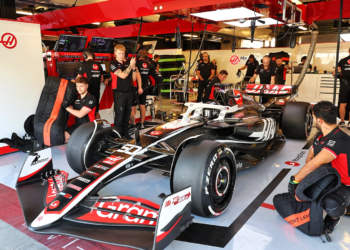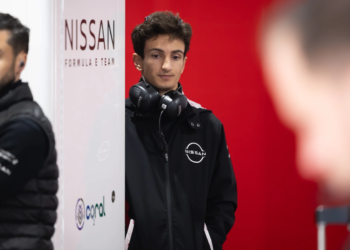Three – that’s the magic number, as De La Soul once sang. Mercedes boss Toto Wolff agrees, and thinks this magic number will solve a Formula 1 problem. Or more to the point solve a Toto Wolff problem.
That the ultra-talented and promising Esteban Ocon, from the Mercedes stable, suddenly is left without an F1 race seat for next year. Which in turn has led to a familiar round of self-recrimination, that this is an indictment of modern F1 and the opportunities it offers to budding driving talent.
Letting F1 teams run a third car rather than the standard two will solve this, Wolff reckons. “It’s a bone he won’t let go,” noted Glenn Freeman. That another Merc protégé George Russell, on his way to winning F1’s direct feeder championship F2, also has apparently nowhere to go for 2019 only underlines the problem.
It’s not just Wolff who likes the rule of three. Mario Andretti, Pat Symonds and others have also advocated three-car teams recently. Their appeal is obvious – it would at a stroke open up for drivers racing opportunities that do not currently exist, in an age wherein such opportunities are scant. Maybe more scant than they’ve ever been.
You could get creative with it too – reserve the third seat only for inexperienced drivers; crowd-drawing one-off local entries could be raced as well.
“Can you imagine the promotion if say Josef Newgarden as IndyCar champion would be invited by Mercedes or Ferrari or Red Bull as a third car for the US GP?,” asked Andretti. “It would add another 40,000 people [to the gate] probably.”
It is undeniable that F1 driving opportunities are at something like an historic low, with the total of 20 race seats small by historic standards and the 26-car capacity not reached since the Monaco Grand Prix way back in 1995. Add that with testing restrictions a team’s testing role – once vital to the likes of Fernando Alonso and Robert Kubica getting their breaks – is not nearly as plumb as it once was, as well as that F1 careers generally are longer these days meaning rarer vacancies.
Can you imagine the promotion if say Josef Newgarden as IndyCar champion would be invited by Mercedes or Ferrari or Red Bull as a third car for the US GP? It would add another 40,000 people [to the gate] probably – Mario Andretti
While, as is the case with many mooted F1 remedies, varying from the two-car team used to be fairly common with single-car entries (whatever happened to those?) and squads of upwards of two not at all unusual. BRM indeed started the 1972 season with five works entries; even at the time though it was suspected it was spreading itself rather thinly. IndyCar in the modern day also has that sort of variation, with Ganassi and Penske entering four cars each in 2017 and single-car efforts being fairly common.
F1’s last three-car entry was in the German Grand Prix of 1985, when Renault added a car for Francois Hesnault (thus providing F1’s last ever 27-car race…), and for the peculiar reason of carrying F1’s first in-race onboard live camera. Amusingly he was under instructions to make sure he was always near other cars – slowing down to let those behind catch up if needed – to provide interesting footage. Since the early 1990s though F1’s commercial agreements have specified two-car teams unless the crisis hits of several teams going bust and grid numbers need to be boosted in short order.
It’s worth however remembering a few points. First off, the specific case of Ocon being left high and dry to some extent owes to peculiar happenings. Had Daniel Ricciardo not astounded us all by jumping from Red Bull to Renault Ocon would have slotted in at Regie just fine and we likely wouldn’t be having this conversation. Add that the other two of F1’s ‘big three’ teams are in fact giving one of their young driving protégés a chance in race seats for 2019 – Charles Leclerc at Ferrari; Pierre Gasly at Red Bull – and we’d have plenty of reasons to be cheerful about the opportunities young talent was getting (or we would be were it not for modern F1’s immutable capacity for self-loathing).
A few also have pointed out not entirely unreasonably that if Wolff is so concerned about Ocon and Russell getting an F1 race drive then he could offer them the two that are in his gift… As well as that Mercedes’s and other big teams’ current arrangement of hoovering up much of F1’s money has made it much harder for the smaller squads to pick drivers such as Ocon or Russell on talent rather than on their quantity of sponsors’ cash.
Another point is that F1 has always had limited opportunities, has always been brutal and has far from always been fair. We may recall the case of John Watson in 1983, considered among the very best F1 drivers at the time and indeed had won a race and outscored team-mate Niki Lauda that year. But suddenly at the campaign’s 11th hour he had his F1 career ended when Alain Prost was sacked by Renault and snapped up by McLaren, leaving Wattie with nowhere to go. Not long later talented drivers such as Derek Warwick and Martin Brundle barely got their F1 breaks and both had to leave for sportscar racing to get their success.
Ocon being left high and dry to some extent owes to peculiar happenings. Had Daniel Ricciardo not astounded us all by jumping from Red Bull to Renault we likely wouldn’t be having this conversation
And while it’s common to hear about 1989 and its 39 available seats, we can grossly exaggerate the extent that it was a panacea. Plenty of those seats were career suicide and more than one promising talent never recovered from the experience of throwing their lot in with them. Well upwards of ten of the seats barely qualified for a race in the whole season; around seven or so barely got past pre-qualifying on Friday morning, them time after time packing up to depart at the point at which most of us weren’t out of bed on the day of opening practice. The seats worth having, in a similar sense to the modern day 20, totalled about 25 at best. Still better than today, but hardly a different planet.
But there’s another F1 perennial that applies here. That while it’s easy to trumpet three-car teams as a solution, working out the details of the implementation and avoiding the many pitfalls is much harder. Likely reflecting as much Wolff hasn’t managed to drum up much enthusiasm for the move among team bosses, beyond his own enthusiasm of course.
First there is how it would impact on constructors’ points, and likely this is the most acute problem given that’s what the money is based on. Back in the day of varying numbers per team it was resolved elegantly by having the constructors’ points come from each team’s highest place car only. But then you can imagine even that being a matter of contention were it to be introduced today, as it would favour teams that have more of a number one/number two driver arrangement (say Ferrari) over teams that run more of an even operation (say Mercedes).
Costs and at-the-circuit personnel numbers (the latter currently is capped) for those running a third car would presumably go up, almost inevitably. This in an era too when most of the agonising is about getting costs down; as well as not letting the more flush large teams stretch ahead and do what they like.
There would be more immediate problems too. If you’ve got sick of F1’s ‘Class A’ and ‘Class B’ arrangement right now, that we can with reasonable confidence predict the pool of cars that will fill the first six places every time, imagine that becomes the first nine places… Which also is nine out of ten points-scoring slots. One can only imagine what the non-‘big three’ squads would make of having their points scoring chances be subject to such a swingeing reduction. As well as that their chances of getting on TV would diminish about as much.
Perhaps we could revise the points system, though that is a can of worms of itself. I’ve also encountered the suggestion to not have the third car eligible for points, but is adding a complication in a formula we already complain is too complicated really what we need? And imagine if a non-scoring car went and won a race.
Some wonder too if a third car would be used tactically in a spoiling role, particularly if it wasn’t eligible for scoring.
It is dealing with the symptoms and not the illness. Third cars would in fact be worse than useless – while masking the symptoms it would make the illness worse
Imagine also that it was a year of single-car domination – something hardly unlikely from recent experience. In this scenario rather than finish one-two everywhere the dominant team would finish one-two-three everywhere. The chances of the unusual interloper winner caused by unreliability or other intervention would reduce from an already small level.
Also if we are to reserve each team’s third car for budding young drivers – as otherwise what’s the point of them – at what point do we draw the line? Two years’ F1 experience maximum seems a fair enough place? Well that would already rule Ocon out of the Mercedes gig.
Then there is the biggest issue with allowing third cars, that it is dealing with the symptoms and not the illness. The illness at the root of all this also will by now sound familiar – excessive cost and heavily skewed financial distribution favouring the handful at the top. And as noted third cars on this would in fact be worse than useless – while masking the symptoms it would make the illness worse.
We can take some comfort that Liberty has identified these fundamental cost points as things to sort, although the implementation remains to be seen. The brave new formula is due for 2021, only a year after three-car teams could realistically be brought in – given it seems rather late now to change something like this for 2019.
So all in all, for all its initial temptations, it’s hard to see what a three-car teams move has going for it.






